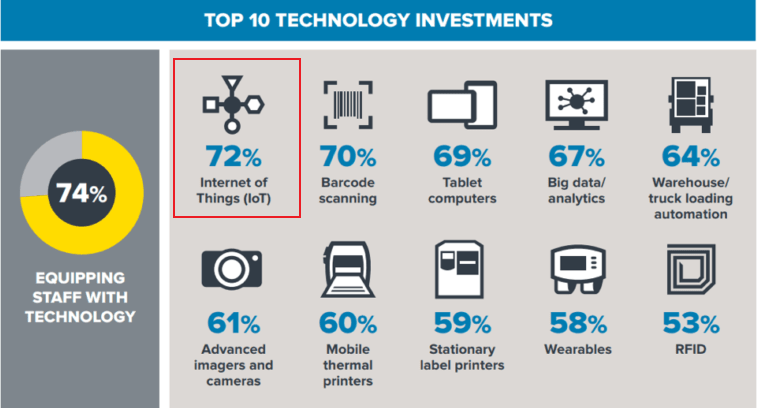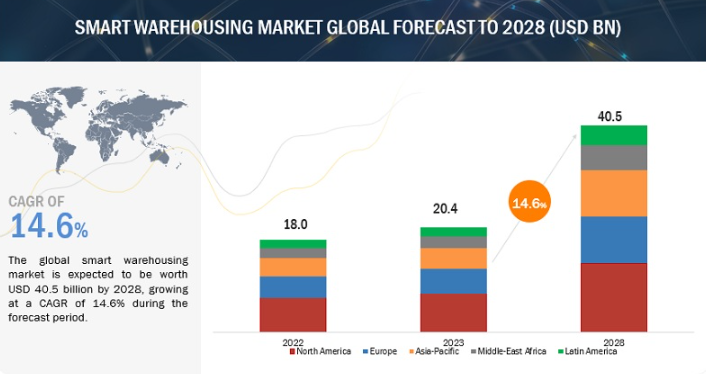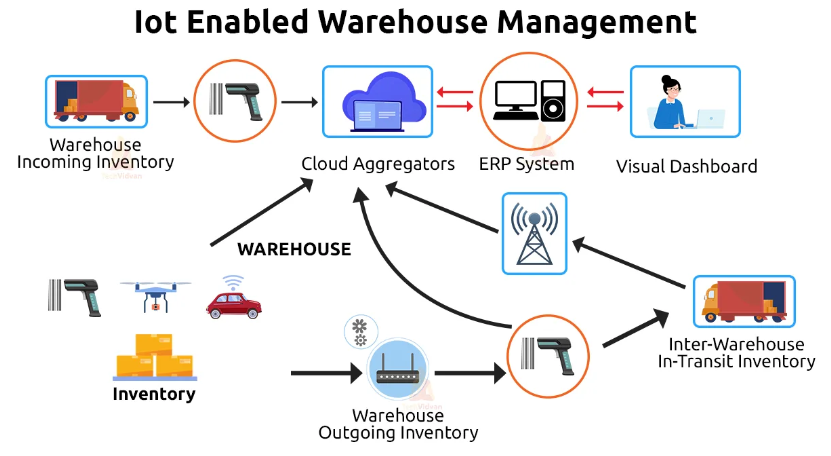Introduction
The global landscape of logistics and supply chain management is undergoing a seismic shift. Fueled by the Internet of Things (IoT), warehouses are transforming from static storage facilities into dynamic hubs of efficiency, connectivity, and control. This comprehensive guide explores the profound impact of IoT on warehouse management, revealing how it is revolutionizing the way goods are stored and handled across the globe.

Source: WarehousingAndFulfillment
Over 70% of companies are planning to automate their warehouse using IoT in the next five years. This staggering statistic underscores the pivotal role IoT is set to play in the evolution of warehousing, marking a paradigm shift towards fully automated, intelligent storage systems that promise unprecedented levels of operational efficiency and accuracy. Such a transformative approach not only addresses the challenges of modern-day logistics but also sets a new standard for the industry, ensuring that warehouses are not merely storage spaces but vital cogs in the supply chain machinery, optimized for speed, efficiency, and adaptability.
While traditionally warehouses played a vital, although often overlooked, role in global trade, they are struggling to keep pace with the rapid demands of today's interconnected and fast-paced commerce. Enter IoT, a game-changing technology that provides innovative solutions to the challenges of speed and seamless integration, propelling warehouses into the future of logistics.

Source: Smart Warehousing Market
The Essence of IoT in Modern Warehousing
IoT encompasses the network of physical objects worldwide that can collect and share data through wireless connections. This includes everyday gadgets like smartwatches, thermostats controlled via smartphones, and voice assistants like Google Assistant or Amazon Alexa.
Leveraging cloud-based platforms,
IoT solutions and applications employ machine learning algorithms to sift through vast amounts of sensor data, providing insights into performance metrics, failure rates, and more. These capabilities enable businesses to refine their operations across various domains, including supply chains, customer service, and financial management.
In the realm of warehousing, IoT stands as a cornerstone technology, enabling a seamless fusion of physical and digital elements within the supply chain. The advent of IoT ushers in an era of smart warehouses, where every item, from pallets to products, becomes a source of data, offering a granular view of operations in real-time. This integration of IoT devices and sensors into warehousing operations opens up new avenues for optimization, from inventory management to energy consumption, thereby not only enhancing operational efficiency but also contributing to a sustainable and resilient supply chain ecosystem.
Transforming Warehousing with IoT: Efficiency and Profitability
A significant shift toward
industrial automation, with over 70% of businesses planning to incorporate IoT technologies into their warehouses within five years, highlights the urgency of adopting these advancements.
Traditional warehousing faces numerous challenges, such as product damage, spoilage, and logistical inefficiencies, which IoT aims to address. By providing real-time insights into the status and conditions of goods, IoT facilitates more effective management and reduces unnecessary costs.
The integration of IoT in warehousing goes beyond mere automation; it drives a new era of data-driven decision-making and operational excellence. By harnessing the power of real-time data, warehouses can now anticipate demand fluctuations, optimize stock levels, and reduce lead times, ensuring that the right products are available at the right time. This proactive approach to warehouse management not only improves the bottom line by reducing waste and inefficiencies but also enhances customer satisfaction by ensuring timely and accurate deliveries. In this way, IoT serves as the key player for creating a more agile, responsive, and competitive logistics infrastructure, capable of adapting to the ever-evolving demands of the global market.
IoT at Work: Enhancing Warehouse Operations
IoT's implementation in warehouses involves the strategic placement of devices like RFID tags, sensors, and smart cameras to monitor goods and equipment constantly. This real-time data collection and analysis drive improvements in accuracy, efficiency, and transparency within warehouse operations, enabling precise inventory management, optimized routing, and proactive maintenance.

Source: TechVidvan
Leading the Way: Futurism’s IoT Warehouse Solutions
Futurism Technologies stands at the forefront of this technological revolution, offering state-of-the-art
IoT-powered warehouse management solutions. These innovations not only streamline inventory and logistics operations but also align with sustainability objectives, marking a leap toward eco-friendly warehousing.
The integration of IoT in warehouses by Futurism Technologies brings forth a suite of advantages, from improved visibility and inventory management to predictive maintenance and efficient order processing, culminating in substantial cost reductions.
Conclusion: The Future of Warehousing with IoT
The integration of IoT, alongside advancements in AI, is redefining the logistics and supply chain sector to meet the demands of a fast-moving world that values efficiency and timely delivery. By championing sustainability and reducing operational costs, IoT technology fosters eco-conscious warehousing practices. Futurism Technologies is at the helm of this transformation, crafting the future of smart warehousing with cutting-edge AI and IoT-driven solutions.
To discover how IoT can revolutionize your warehousing operations, connect with our IoT experts to explore our cutting-edge
IoT solutions suite.


